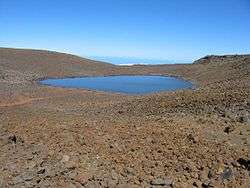Lake Waiau
| Lake Waiau | |
|---|---|
 | |
| Location | Mauna Kea, Hawaii |
| Coordinates | 19°48′40″N 155°28′39″W / 19.811248°N 155.477374°WCoordinates: 19°48′40″N 155°28′39″W / 19.811248°N 155.477374°W |
| Catchment area | 0.135 km2 (0.052 sq mi) |
| Basin countries | United States |
| Max. width | 0.1 km (0.062 mi) |
| Surface area | 0.006 km2 (0.0023 sq mi) |
| Max. depth | 2–2.5 m (6.6–8.2 ft) |
| Surface elevation | 3,970 m (13,020 ft) |
Lake Waiau is a high-elevation lake located at 3,970 m (13,020 ft) above sea level on Mauna Kea, on the island of Hawaiʻi. It is arguably one of the highest lakes in the USA,[1][2] and one of very few lakes at all in the state of Hawaiʻi. It is relatively small, only about 100 m across, and varies in size as the water level rises and falls. At high water levels a small outlet stream appears at the northwest end, but it is absorbed into the ground after a short distance. The name means "swirling water" in Hawaiian, though it is usually rather placid. It usually freezes in winter, but aquatic insects such as midges and beetles can be found breeding in the water.
Description
Lake Waiau is located inside the Pu'u Waiau cinder cone at an altitude of 3970 m. It is approximately heart shaped and its diameter reaches about 100 m. The average surface area of the lake is around 6000 m2. The size of its surface area fluctuates significantly over the year. It reaches its peak during spring with a maximal depth between 2 m and 2.5 m and by the end of the summer it often has shrunk to one third of its original size with a maximal depth below 1 m. A spillover into the Pohakuloa Gulch occurs, when the lake depth is more than 2.3 m. The lake is only fed precipitation which occurs primarily during the winter, its catchment area is about 135,000 m2 mostly located within Pu'u Waiau cinder cone.[1]
The lake is an anomaly in the peak region of Mauna Kea as everywhere else the ground is unable to retain water. The exact nature of the impermeable ground layer of the lake is still unknown. It is assumed, that fine-grained densely compressed ash, basalt rock or small permafrost layer may play a role. No permafrost layer has been established so far for the lake area itself, but it was found at another location in peak area. Established however is 7.5 m thick sediment layer at the bottom of the lake.[1][3]
Temporary shrinkage after 2010
Since 2010 the lake has shrunk significantly and by September 2013 the lake was reduced to a mere puddle with less than 2% of its original surface size. The exact causes for the water loss are unknown. The suspects are drought conditions and the thawing of an assumed permafrost layer under the lake leading to increased seepage.[4] After particularly wet winter in 2013/2014 however the lake recovered to around 75% of its original size in May 2014. Therefore, it is currently assumed that primary reason for the water loss were the drought conditions on Mauna Kea from 2010 to 2013.[5]
Mythology
The lake is of some importance in Hawaiian mythology. Aside from Poliʻahu, there are two additional snow deities, Lilinoe and Waiau, who are associated with Mauna Kea, and according to Westervelt, the lake was probably named after the goddess of the same, who used to bathe in it. Originally, Hawaiians considered the whole peak region of Mauna Kea, including Lake Waiau, a sacred site, and only priests and chieftains were allowed to access it. Later, after the formation of the Hawaiian kingdom, the peak region was occasionally visited by members of the royal family. The last one to do so was queen Emma in 1881, who also took a bath in the lake during her visit.[6][7]
Gallery
-

view from above
-

with a person for scale
-

outlet stream
Further reading
- Jane Ellen Massey: Lake Waiau: A Study of a Tropical Alpine Lake, Past and Present. University of Hawaii Press, 1978
- Alfred H. Woodcock, Meyer Rubin, R. A. Duce: Deep Layer of Sediments in Alpine Lake in the Tropical Mid-Pacific. Science, New Series, Vol. 154, No. 3749 (Nov. 4, 1966), pp. 647–648 (JSTOR)
Notes
- 1 2 3 Ehlmann, Bethany L.; Raymond Arvidson,; Bradley Jolliff,; Sarah Johnson,; Brian Ebel,; Nicole Lovenduski,; Julie Morris,; Jeffery Byers,; Nathan Snider,; Robert Criss,. Hydrologic and isotopic modeling of alpine Lake Waiau, Mauna Kea, Hawai'i. (1). Pacific Science. 2005. HighBeam Research. (February 16, 2014). http://www.highbeam.com/doc/1G1-129714347.html
- ↑ "The Highest Lake in the USA". Retrieved 2008-10-11.
- ↑ Alan C. Ziegler: Hawaiian Natural History, Ecology, and Evolution. University of Hawaii Press, 2002, ISBN 0824821904, S. 94 (excerpt, p. 94, at Google Books)
- ↑ Disappearing Lake Waiau Is a Mystery to Scientists. Honolulu Star - Advertiser. 2013. HighBeam Research. (February 16, 2014). http://www.highbeam.com/doc/1P3-3122526991.html
- ↑ Erin Miller: On the rise: Lake Waiau benefits from wetter weather. Hawaii Tribune Herald, 30. Mai 2014
- ↑ Hawaiian Culture & Mauna Kea auf den Webseiten der Mauna Kea Visitor Information Station (abgerufen 22. Februar 2014)
- ↑ H. Arlo Nimmo: Pele, Volcano Goddess of Hawai'i: A History. McFarland, 2011, ISBN 9780786463473, S. 28 (excerpt, p. 28, at Google Books)
External links
| Wikimedia Commons has media related to Lake Waiau. |
- Volcano Watch: Lake Waiau is shrinking fast at Hawaii 24/7
- Lake Waiau, Hawaii, USA at lakelubbers.com
- Mauna Kea - The Hike To Lake Waiau at instanthawaii.com
- Lake Waiau